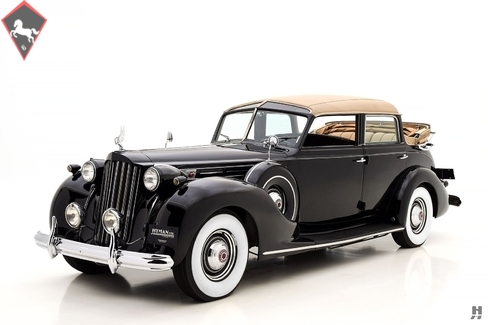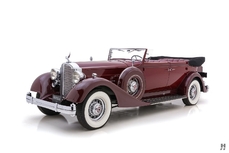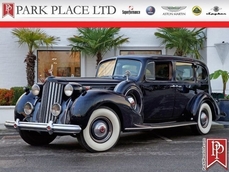Packard Twelve Brunn Touring Cabriolet 1939
Allgemeine Beschreibung :
Introduced in 1939, Packard’s 17th series marked the final year for the legendary and long-running twelve cylinder model. The permanent effects of the Great Depression were taking hold as annual sales of the flagship Twelve dipped to just 500 units, largely due to the fact that the era of custom-bodied automobiles was fading quickly. Since the end of the Great Depression, orders for bespoke bodies had dwindled dramatically for all manufacturers. Many of the great coachbuilders hadn’t even survived the economic downturn, but thankfully a few of the more well-established houses did survive and continued to produce bodies for those few wealthy individuals who still valued the prestige of a custom-built motorcar.
One such coachbuilder was Brunn & Co. of Buffalo, New York. Hermann A. Brunn’s bodies were often found fitted to Pierce-Arrow, Packard, Rolls-Royce and particularly Lincoln chassis. Brunn’s German heritage shone through in the exquisite quality of his workmanship as well as the understated, Teutonic designs. Packard took a liking to one Brunn design in particular, the so-called Touring Cabriolet, which was first shown on a Lincoln K chassis. This elegant, formal style featured an enclosed front section, divider window, and an opening Landaulet-style rear treatment. Packard contracted with Brunn to supply a handful of both the Touring Cabriolet and All Weather Cabriolet (the same body but with a removable panel over the driver’s compartment) to sit atop V12 powered 1608 and 1708 chassis. Contrary to the usual practice, running chassis were shipped to Buffalo to be up-fitted by Brunn’s craftsmen. Some of the Packard-supplied panels had to be heavily reworked to meet Brunn’s high standards, resulting in a loss by Brunn on virtually every Touring Cabriolet produced. All told, just 21 were produced over three years; ten in 1937, nine in 1938 and a mere two in 1939.
The Packard Twelve offered is one of those two Touring Cabriolets bodied by Brunn in 1939. Sitting atop a flagship 1708 chassis, this fine motorcar has a rather interesting early history. It was originally sold via the famed California Packard distributor Earl C. Anthony of Wilshire Motors, and it is believed to have been purchased new by Adolph Spreckels, Jr., the exceedingly wealthy heir to the Spreckels Sugar Company and a rather infamous playboy of the period. There’s little doubt he preferred this particular body so he could “be seen” with the landaulet top folded whilst being chauffeured around Southern California. One unusual option is the rear-mounted radio with controls on the right-hand rear armrest. It is said that Spreckles Jr. had the car so equipped to keep up with what the press was reporting about his antics.
The history goes a little blurry from there, where the car traveled north to Washington State where it spent a great deal of time. From there, it went to Arizona and later to Texas before arriving back home in California in 2009. At some point, it received the restoration it wears today which, while older, has held up respectably well. The Brunn body itself remains in sound condition, a testament to the quality of its construction. Black paint is fair, showing some cracks, texture, and flaws though it does appear generally sound. The chrome trim is older and in largely good condition, straight and complete with a few flaws and wear found in the plating. The car is accessorized with dual Trippe driving lamps, a Packard Cormorant mascot, and a rear rack to supplement the built-in trunk. The tan fabric topping material is in good order with no rips or damage, but showing some fading.
The interior presents in very good condition, having held up very well since the restoration. As is common practice with a chauffeur-driven car, the driver’s compartment is trimmed in black leather to resist dirt and wear. The leather is in good condition, having taken on a moderate patina, though is free of severe cracking or fading. The instrument panel features a woodgrain finish with well-preserved instruments and very good quality original switchgear. The dash header and door caps are crafted from solid wood and very nicely presented with some wear apparent. One interesting feature of the body is found on the window sills, where piano-hinged chrome strips cover the slots when the windows are open. It’s a totally unnecessary but lovely touch that shows the level of detail Brunn built into this fine motorcar. In the rear, camel-colored broadcloth covers the seats and door cards and shows in very good order with minimal wear. The divider window works as it should, and the central bulkhead is capped in wood and adorned with a lovely inset Jaeger clock.
The wonderfully smooth V12 engine is well detailed in correct colors, with good quality paint and period appropriate fittings. It runs well and appears to have seen some miles since the restoration, with some of the enamel baked off in places, but is overall very tidy and sound.
This fine Packard has an interesting story to tell, and it presents in a very usable and attractive condition. The combination of the very rare and beautifully constructed Brunn coachwork and the robust performance from this, the final year of the Packard V12 engine make it very well suited for CCCA, AACA or Packard club touring.
https://hymanltd.com/vehicles/5978-1939-packard-twelve-brunn-touring-cabriolet/
1939 Packard Twelve Brunn Touring Cabriolet is listed verkauft on ClassicDigest in St. Louis by Mark Hyman for $159500.
Fakten der Auto
Karosserietyp : Auto Marke : Packard Modell : Twelve Ausführung : Brunn Touring Cabriolet Hubraum : 0.0 Modelljahr : 1939 Karosstyp : Kombi Lage : Missouri
Verkauft
Angaben Zum Verkäufer
Verkauft
People who viewed this Packard Twelve also viewed similar Packard listed at ClassicDigest
Other cars listed for sale by this dealer
über Packard
Packard: Eine umfassende GeschichteFrühe Jahre und Stiftung:
Gründung: Die Packard Motor Car Company wurde 1899 in Warren, Ohio, von James Ward Packard, William Doud Packard und George Lewis Weiss gegründet.
Pionierluxus: Packard produzierte zunächst hochwertige Automobile und wurde zum Synonym für Luxus, Handwerk und technische Exzellenz.
Bemerkenswerte Erfolge und Beiträge:
Packard Twin Six: Das 1916 eingeführte Auto wurde Packard als Premier Luxury Automobile Marke eingerichtet.
Modelllinienerweiterung: Packard hat seine Aufstellung mit verschiedenen Modellen erweitert, darunter Limousinen, Coupes, Cabrios und Limousinen, die an wohlhabende Kunden geliefert werden, die Eleganz und Leistung suchen.
Engineering Innovations: Die Marke führte mehrere Innovationen ein, z.
Zehn historisch bedeutende Modelle mit technischen Spezifikationen:
Packard Twin Six (1916):
Motor: 7.3L V12 Motor.
Leistung: rund 85 PS.
Packard acht (1930-1938):
Motor: Straight-8 Motor mit verschiedenen Verschiebungen.
Leistung: reicht zwischen 90 und über 130 PS.
Packard Super Eight (1939-1951):
Motor: Straight-8 Motor.
Leistung: Produktion zwischen 130 und 180 PS.
Packard One-Twenty (1935-1942):
Motor: Straight-8 Motor.
Leistung: ca. 100 bis 120 PS.
Packard Clipper (1941-1957):
Motor: V8 Motor.
Leistung: reichen von 135 bis 185 PS.
Packard Caribbean (1953-1956):
Motor: V8 Motor.
Leistung: variiert zwischen 275 und 310 PS.
Packard Patrician (1951-1956):
Motor: Inline-8- und V8-Motoren.
Leistung: reicht von 150 bis 180 PS.
Packard Hawk (1958):
Motor: V8 Motor.
Leistung: Erzeugt um 275 PS.
Packard Executive (1956-1958):
Motor: V8 Motor.
Leistung: variiert zwischen 240 und 290 PS.
Packard Predictor (1956):
Motor: Konzeptauto präsentieren Design und Technologie.
Leistung: Prototypmodell.
Vermächtnis und Einfluss:
Qualität und Eleganz: Packard wurde wegen seiner außergewöhnlichen Verarbeitungsqualität, des raffinierten Stylings und seiner Luxusmerkmale verehrt, die häufig mit europäischen Luxusmarken wie Mercedes-Benz auf A-A-Niveau berücksichtigt wurden.
Produktionsende: Die Marke hatte in den 1950er Jahren finanzielle Kämpfe, was zu ihrer Fusion mit Studebaker und letztendlich Ende der 1950er Jahre führte, was das Ende einer Ära in amerikanischen Luxusautomobilen kennzeichnete.
Packard hinterließ ein dauerhaftes Erbe in der Automobilindustrie, symbolisierte Eleganz, technische Exzellenz und ein Engagement für Luxus, das weltweit von Autoenthusiasten bewundert und respektiert wurde.









